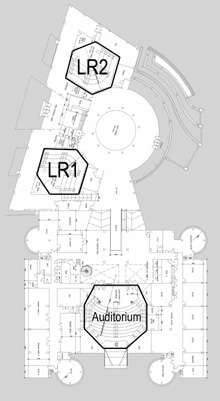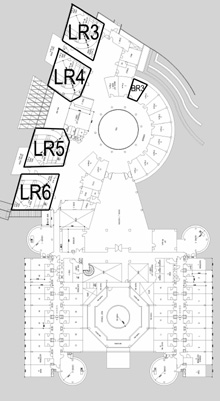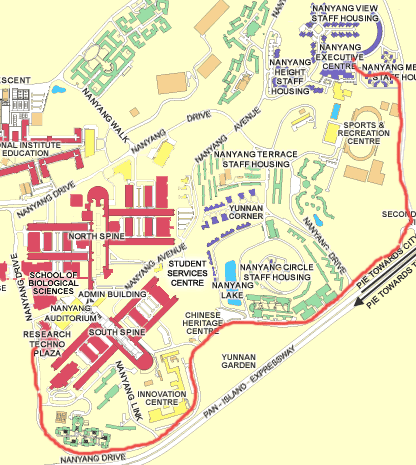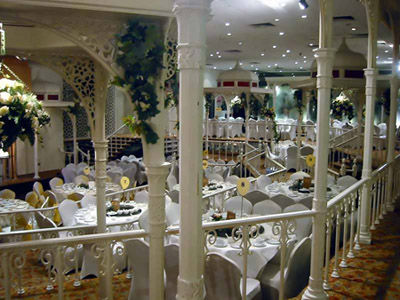|
NEWS: How to get to the conference venue
Registration on 22 November will be held in the secretariat room, 3rd floor
Since most of the participants are arriving late on 22 November, the welcome reception is shifted to morning 23 November, just before the opening.
Various demos and hands-on will be shown in NTU Research TechnoPlaza during the Lab Tour. The lab tour will be followed by a dinner at NEC from 8:00pm to 9:00pm. For catering and logistic purposes, please email to cyberworlds@ntu.edu.sg your intention to join the tour.
New Lab Presentation
by
Brian Wyvill, GraphicsJungle Research Group, Computer Science Department, University of Calgary,
Canada
Accommodation booking is open, subject of
room availability.
Speakers please refer to Presentation Details
Those who are interested in purchasing the proceedings of the past conference CW2004 at S$30, please email us to cyberworlds@ntu.edu.sg. No pre-payment will be required but we need to arrange in advance the delivery of the proceedings to the conference. |
CW2005 has the following parallel sessions:
-
Full Conference Papers:
- Shared and Collaborative Cyberworlds (SCC)
- Distributed Cyberworlds (DCW)
- Information Security (SEC)
- Data Retrieval and Data Mining (DRDM)
- HCI and Humanized Interfaces in Cyberworlds (HCI)
- Cyber-education (EDU)
- Cyber-business (BUS)
-
Short Conference Papers (SP)
-
LUAR 2005 papers
-
WCCW 2005 papers
-
Industrial presentations (IP)
Conference at-a-Glance
Last time updated: 22-Nov-2005 09:09 (GMT+7)
| 22 November, Tuesday | ||||||
|
15:00-18:00 |
Registration: Conference secretariat room, 3rd floor |
|||||
| 23 November, Wednesday | ||||||
| 09:00-17:45 | Registration: Lobby 2nd floor, Secretariat room 3rd floor | |||||
| 09:00-10:00 | Welcome Reception: Lobby 2nd floor | |||||
| 10:00-10:30 |
Opening:
Auditorium Guest of honor: Professor Su Guaning, President of NTU |
|||||
| 10:30-11:30 | Key-note Talk 1: Auditorium | |||||
| 11:30-12:00 | Coffee break: Lobby 2nd floor | |||||
| Sessions | LR3 | LR4 | LR5 | LR6 | BR3 | Lobby |
| 12:00-13:30 | WCCW1 | LUAR1 | SCC1 | SEC1 |
Demo |
Book exhibition and sale |
| 13:30-14:30 | Lunch: Function room 3rd floor | |||||
| 14:30-16:00 | WCCW2 | LUAR2 | SCC2 | SEC2 | ||
| 16:00-16:30 | Coffee break: Lobby 3rd floor | |||||
| 16:30-18:00 | WCCW3 | LUAR3 | SCC3 | DRDM | ||
| 17:30-18:15 | LAB1 | |||||
| 18:30-20:00 | Lab Tour to NTU Research TechnoPlaza | |||||
| 20:00-21:00 | Dinner: NEC Lobby, level 2 | |||||
| 24 November, Thursday | ||||||
| 08:30-17:30 | Registration: Secretariat room 3rd floor | |||||
| 09:30-10:30 | Key-note Talk 2: LR1 | |||||
| 10:30-11:00 | Coffee break: Lobby 3rd floor | |||||
| Sessions | LR3 | LR4 | LR5 | LR1 | BR3 | Lobby |
| 11:00-12:30 | WCCW4 | LUAR4 | HCI1 | EDU1 |
Demo |
Book exhibition and sale |
| 12:30-13:30 | Lunch: Function room 3rd floor | |||||
| 13:30-15:00 | Industrial talks: LR1 | |||||
| 15:00-15:30 | Coffee break: Lobby 3rd floor | |||||
| 15:30-17:30 | BUS | DCW | HCI2 | EDU2 | ||
| 17:00-18:00 | LAB2 | |||||
| 18:30-19:30 |
Conference bus: transport to Act One ballroom
at the 35th floor of Meritus Mandarin Hotel-Grand Tower, 333 Orchard Rd. |
|||||
| 19:30-20:00 | Cocktail and reception | |||||
| 20:00-22:00 | Banquet, entertainment program | |||||
| 22:15-22:45 | Conference bus: transport back to NTU | |||||
| 25 November, Friday | ||||||
| 08:30-17:00 | Registration: Secretariat room 3rd floor | |||||
| 09:30-10:30 | Key-note Talk 3: LR1 | |||||
| 10:30-11:00 | Coffee break: Lobby 2d floor | |||||
| Sessions | LR1 | Lobby | Lobby | |||
| 11:00-12:30 | Short Papers, SP1 |
Demo |
Book exhibition and sale | |||
| 12:30-13:30 | Lunch: Function room 3rd floor | |||||
| 13:30-15:00 | Short Papers, SP2 | |||||
| 15:00-15:30 | Coffee break: Lobby 2d floor | |||||
| 15:30-17:00 | Short Papers, SP3 | |||||


2nd floor
3rd floor
Each conference room is equipped with
a personal computer running MS Windows XP and MS Office, a large screen
projector, microphone and Internet access (wired and Wi-Fi). Please refer to
the conference web page and click at the links there to see how the rooms
look like. The presenters will be able to use their own notebooks should
they decide to do so. Alternatively, please bring along your files in Ms
PowerPoint format on
CD-ROM or USB drive. The files have to be copied to the computer before the
respective session. Each conference room will be served by one of the
student volunteers (speaking English and Chinese) who will assist you with
this.
Please remember to send us the speaker's bio if you have not done it yet. Before the session, please identify yourself to your session chair.
Full Paper Speakers will have 25 min for presentation and
5 min for Q&A.
Short Paper Speakers will have 10 min for presentations and 3 min for max 2
questions only. Due to the time constrains, there will be no official poster
session accompanying the Short Paper sessions however should the authors of
short papers want to make demos running on your notebooks in the lobby after
the session during the coffee breaks, they will be able to do so. Please let
me know then so that we will make a space for you.
Wi-Fi Internet will be available at any place of NEC for those delegates who stay at NEC. For those who stay downtown, we will make available 2-3 PC connected to the Internet for checking emails. We will be also able to lend you a limited number of Wi-Fi logins.
Key-note Talks
Key-note Talk 1:
Cyberworld Modeling: Integrating Cyberworlds, the Real World and Conceptual Worldsby Tosiyasu L. Kunii, Kanazawa Institute of Technology
The globalization of the real world we live in has been almost exploding in its speed and scale in all the key aspects including business, economy, industry, education and culture, making it hard for human beings to cognize what's going on. Thus the links between the real world and conceptual world is getting weaker. The globalization is mainly driven by the Web-based activities in their cyberspaces creating cyberworlds as seen in e-business, e-commerce, e-manufacturing, and cultural heritages through the Web and on the Web. Thus the links between the real world and cyberworlds are becoming ever tighter nonlinearly in time and space. It is now crucial to find a way to automatically integrate the dynamically changing worlds, namely the real world, cyberworlds and conceptual worlds, fast enough. It is a hard task owing to the vast complexity of the worlds to be integrated, and it requires an advanced abstraction modeling. This talk is an interim progress report on it, presenting the outline based on the previous works on the abstraction hierarchy modeling of cyberworlds, imposing minimal cover generation at each level of the abstraction as a new and realistic method, and utilizing available high speed computation such as grid computing. The design issues of the modeling are also discussed.
is currently Director of IT Institute and Professor at the Department of Computer and Information Engineering, Graduate School of Engineering, Kanazawa Institute of Technology. Before that, he was Professor at Hosei University. He is also Honorary Visiting Professor of University of Bradford, and Professor Emeritus of the University of Tokyo and of the University of Aizu of which he was the Founding President from 1993 to 1997. He received his B.Sc. in 1962, M.Sc. in 1964 and D.Sc. in 1967, all from the University of Tokyo. He had been Professor at the Department of Computer and Information Science at the University of Tokyo from June 1978 until March 1993. He has also contracted both academic and commercial licenses with Bell Laboratories. He received the 1998 Taylor L. Booth Education Award from the IEEE Computer Society, the highest educational award of IEEE Computer Society which is given to one individual annually. In January 1991 he was elected Fellow of IEEE for his contribution to visual computer and visual computation. He was also elected Fellow of the Information Processing Society of Japan (IPSJ) for ‘International Contributions to Pioneering in and Establishing the Discipline of Visual Computing’, March 14, 2000. He authored and edited around 50 books in computer science and in general areas, and published over 300 refereed original academic/technical papers in computer science and applications. Professor Kunii is a founder of the International conferences on cyberworlds.Key-note Talk 2:
Cybermedicine – What is possible, and is it
useful?
by Nigel W. John,
University of Wales, Bangor, UK
The
medical domain provides excellent opportunities for the application of
computer graphics, visualization, and virtual environments, with the
potential to help improve healthcare and bring benefits to patients.
Possible applications include anatomical educational tools; diagnostic
aids; virtual endoscopy; planning aids; guidance aids; skills training;
and computer augmented reality. This talk will provide a comprehensive
overview of the state-of-the-art in this exciting field, including
examples from research projects and commercially available products. The
term Cybermedicine will be introduced to categorize those medical
applications that can be delivered via the World Wide Web, preferably in
the context of a collaborative virtual environment. The issues for
effective cybermedicine will be discussed, and we will look ahead to
future developments.
Nigel W. John holds a chair in computing at the University of Wales, Bangor, UK, where he leads research activities in high performance visualization and medical graphics. He was formally the head of the Manchester Visualization Centre, and has worked in industry for Zeneca Pharmaceuticals and Silicon Graphics. He has been responsible for a variety of projects funded by the UK Research Councils and European Commission involving visualization, virtual reality, and Web3D applications. Professor John is an active member of the Eurographics Association, where he is currently the chair of the Eurographics Professional Board. Prof. John was co-chair of the EG2001 conference, and organized the ACM SIGGRAPH Web3D 2005 Symposium. He is co-chair of the Web3D Consortium’s Medical Working Group.
Key-note Talk 3:
Combining the Real and Cyber worlds using Mixed Reality and Human Centered
Media
by Adrian David Cheok, Nanyang Technological University
This talk outlines new facilities within ubiquitous human media spaces supporting embodied interaction between humans and computation, both socially and physically, in both the real world and cyber world. The research has the aim of developing novel interactive computer work and entertainment. We believe that the current approach to developing electronic based entertainment environments is somewhat lacking with regard to support for multi-person multi-modal interactions. In this talk, we present an alternative ubiquitous computing environment based on an integrated design of real and virtual worlds. We discuss some different research prototype systems: the Virtual Kyoto Garden, Touchy Internet, Tilt-Pad, Magic Land, and the Human Pacman. The functional capabilities implemented in these systems include spatially-aware 3D navigation, tangible interaction, and ubiquitous human media spaces. Some of its details, benefits, and issues regarding design support are discussed.
Adrian David Cheok
is Director of the
Interaction and Entertainment Research Center at NTU. He is also
Associate Professor in both the
School of Computer
Engineering and
School of Art, Design, and Media. He has previously
worked in real-time systems, soft computing, and embedded computing in
Mitsubishi Electric Research Labs, Osaka, Japan, and NUS. He has been
working on research covering mixed reality, human-computer interaction,
wearable computers and smart spaces, fuzzy systems, embedded systems, power
electronics, and multi-modal recognition. He leads a team of over 20
researchers and students. He was IEEE Singapore Section Chairman 2003, and
is presently ACM SIGCHI Chapter President. He was awarded the Hitachi
Fellowship 2003, the
A-Star Young Scientist of the Year Award 2003, and the SCS Singapore Young
Professional of the Year Award 2004. In 2004 he was invited to be the
Singapore representative of the United Nations body IFIP SG 16 on
Entertainment Computing, and the founding and present Chairman of the
Singapore Computer Society Special Interest Group on Entertainment
Computing.
Industrial Presentations and Exhibitions
24 November
SUN
Microsystems Inc., Mr. T. Mohandoss
Changing Trends in Computing - Distributed Clusters & Horizontal
Scaling
Computing is undergoing rapid changes. First the architecture changes in
technical computing workloads. The need to build faster and cost effective
infrastructure have pushed the technical computing architecture to 'shared
nothing clusters'. How better the architectures of Opteron Processor and
InfiniBand Interconnect are making impact as a case in point is suggested.
In Business computing the shift from client/server to web centric
computing model and the rise of J2EE and .NET are giving option to scale
horizontally. Oracle, MS SQL server and IBM DB/2 are also pushing the
architecture toward Grid databases or clustered DB.
The third area is virtualization. In Technical computing
workloads Grid has gained ground but now Virtualization is also making its
presence felt in business computing workloads.
T.Mohandoss is Director - Volume Solutions, Asia South Sun Microsystems. He is with Sun for more than 10 years in Sales, Product Management, and Industry Business Development. Mohan has total of 19 years experience in IT and he is a mechanical engineer with an MBA degree.
SGI Pte Ltd,
Jeff AdieThe SGI Reality Center - A portal into Cyberworlds
The SGI Reality Centre provides customers with a collaborative, immersive virtual environment for the access, development and design of their virtual content, be it the latest mockup of an automobile design, or a recreation of the birth of the Universe. First deployed in July 1994, Reality Centers have proven themselves time and again to be extremely successful tools in both research and commercial markets. This talk details the Reality Centre market, looking back at the History of the Reality Centre, examining current uses and trends, and looks into the future to where this technology may take us.
Jeff Adie is a Principal Systems Engineer for SGI and is the Asia Pacific specialist for advanced graphics. Jeff's current interests include research into real-time simulation and rendering of large, complex scenes. Jeff provides technical advice to production houses and consults on many projects, including a recent stint as a contract VFX supervisor for an Australian production. As a principal engineer, Jeff is also involved with current and future visualization products that SGI is developing. Before joining SGI, Jeff worked as a senior VFX artist with Gibson Group Ltd.; as a consultant with Eagle Technology Ltd.; as a graphic artist for Video Images Ltd., and as a designer for ComputerVision Corp. He also founded and managed a successful private design company, Dataworks Design Limited, providing creative and consultative services to many design and production houses. He holds a postgraduate Diploma of Computer Science in Computer Graphics and Parallel Architecture from the University of Auckland, New Zealand.
Bitmanagement Software, Peter Schickel
International
applications of 3D enabling software
Concepts from cyberspace have become an important factor in engineering today. The convergence of standardized 3D enabling technology in combination with audio and video streaming as well as internet technology is prevailing now with novel applications in industry and commerce. Real-time performance and interactivity of the 3D software technology enables the augmentation of existing products and concepts with 3D visualization. The presentation will cast some light on applications derived from R&D projects based on multi-media standards of the consortia Web3D and MPEG, e.g. VRML, X3D and MPEG-4, and their use in modern industry. Both the possibilities of the technology as well as concepts and examples of use in everyday production will be presented. Bitmanagment offers interactive and real-time 3D enabling technology based on the ISO Standards VRML, X3D and MPEG-4. Founded in 2002 by former employees of Blaxxun Interactive AG, Bitmanagement develops 3D visualization software that is used world-wide in products and concepts in the domains CAD, simulation and presentation. Bitmanagement supports with standardized interfaces to thirdd party technology and project related work the integration of the 3D technology in customer projects. More information is available at www.bitmanagement.com
Peter Schickel is founder of Bitmanagement Software GmbH and leads the company since its foundation in 2002. Prior to that he was head of research at blaxxun interactive AG which was focused to the development of 3D internet software. At blaxxun he was directing the development of 3D viewer technology within 6 EC/BMBF R&D projects and built up a network of leading European Technology Companies. Focus of his work was on the transfer from R&D results into commercial products, e.g. leading to winning the Digiglobe-Award for E-Commerce of Deutsche Telecom and Focus. At the German Aerospace Centre (DLR) in Munich, Germany and the Joint Research Centre of the European Commission (JRC) in Milan, Italy, he was working from 1992 to 1998 at the development of graphical systems in the areas of Virtual Reality, Remote Sensing (GIS) and GPS. He is accredited by the Deutsches Institut für Normung (DIN) for Standardization of VRML and MPEG technologies and is member of the board of directors of the Web3D consortium. Mr. Schickel holds a degree in Information Science from the University of Technology Munich (TUM).
Human-Computer Interaction Lab, University of Udine, Italy
by
Through a gallery of videos and demos, this lab presentation will illustrate some of the cyberworlds-related research and industrial projects that are carried out by the HCI Lab of the University of Udine, Italy. Topics will include:
-
Virtual prototyping of garments for the textile industry (a project carried out in cooperation with the Benetton Group)
-
Immersive flight simulation based on low-cost solutions
-
3D Web sites for learning and training
-
Tools for studying user's behavior in 3D environments, focusing in particular on users' flows in time and space
-
Virtual manuals/training employing humanoid mentors and Web3D technologies
-
Location-aware 3D visualizations on PDAs, and
-
Navigation aids in 3D virtual environments.
Luca Chittaro is a full professor of Human-Computer Interaction in the Department of Mathematics and Computer Science at the University of Udine, Italy. He heads the HCI Lab at the University of Udine and is a chair of the Italian Chapter of ACM SIGCHI. His major research interests are in the area of human-computer interaction (particularly in information visualization, 3D and Web3D interfaces, mobile devices and services). He has authored more than 110 publications. He is a program co-chair of ACM Web3D 2004 and ACM Web3D 2005 (9th and 10th International Symposiums on 3D Web Technology), and a general chair of MOBILE HCI 2003 (5th International Symposium on Human Computer Interaction with Mobile Devices and Services). He is a member of the Editorial Board of the Personal and Ubiquitous Computing journal.
GraphicsJungle Research Group, Computer Science Department, University of Calgary,
Canada
by
Brian Wyvill
In the last 20 years there has been much research into the implicit modeling metaphor, however these techniques are little used in games or commercial animation. The traditional view is that these models are slow to visualize and are restricted to cartoon-like models that cannot be textured. In fact recent work has produced engineering models using CSG, shape control using space warping, detection of contact, animation constraints, and non-photorealistic rendering, all using implicit techniques. Moreover the use of spatial caching and tree pruning has made possible real time interaction. The BlobTree encapsulates these advances and has also been used in a sketch-based system that produces a 3D implicit surface from a few strokes drawn by a designer and textured in real time. In this talk the underlying methodology of the BlobTree is presented along with some of the latest results for modeling highly complex models, such as realistic bio-logical trees, and a new parameterization technique for texture mapping sketch-based implicit surfaces.
Brian Wyvill is a full professor at the University of Calgary, Computer Science department. He received his PhD from the University of Bradford in 1975 and continued his interest in computer animation as a research fellow at the Royal College of Art. After working as a consultant for various animation projects including some scenes from the film 'Alien', he joined the University Calgary faculty in 1981. At Calgary he built up the GraphicsJungle research group and there are now five faculty and about 30 graduate students in the group. In the implicit modeling field, Brian, together with his brother, Geoff Wyvill, have contributed fundamental algorithms such as the first implicit surface polygonizer and more recently the BlobTree data structure and associated algorithms, in which many complex models have been built. Current research interests include implicit modeling, non-photo realistic rendering and sketch based modeling. He is a member of Eurographics, ACM, CGS, and editorial boards of the Visual Computer, Journal of Computer Animation and Virtual Worlds, and the Journal of Shape Modeling. Recently Brian was elected to the Eurographics executive committee.
Paper Sessions
Names
of the registered speakers are underlined.
Last time updated November 22, 2005 09:09 AM
(GMT+7)
FULL PAPERS (34 papers)
Shared and Collaborative Cyberworlds, SCC
SCC1 Session Chair: Anton Nijholt
141: Agent Models for Dynamic 3D Virtual Worlds
Mary-Lou Maher and Kathryn Merrick
National ICT Australia and University of Sydney
157: Function-based Time-dependent Shape Modeling on the Web
Qi Liu and Alexei Sourin
Nanyang Technological University, Singapore
186: Influence of Resolution Degradation on the Distance Estimation in
Virtual Space Displaying Static and Dynamic Image
Jaeho Ryu, Naoki Hashimoto, and Makoto Sato
Tokyo Institute of Technology
SCC2 Session Chair: Stanislav Klimenko
125: A Web-based Configure-to-Order
Platform for Collaborative Development of
Customized Products
Jianxin Jiao, Martin Helander, and L. Zhang
Nanyang Technological University, Singapore
193: The Interactive 3D Breakaway Map: a Navigation and Examination
Aid for Multi-Floor 3D Worlds
Luca Chittaro, Vijay Kumar Gatla, and Subramanian Venkataraman
University of Udine, Italy
198: Augmenting Existing Virtual Environments with Plausible
Naturalistic Clutter
Russell Broughton and Toby Howard
Manchester University, UK
SCC3 Session Chair: Adrian Cheok
169:
Meetings in the Virtuality Continuum: Send Your Avatar
Anton Nijholt
University of Twente, Netherlands
235: HyperMem: A System to Store and Replay Experiences in Mixed
Reality Worlds
Nuno Correia, Luis Alves, Ricardo Sá, Jorge Santiago, and Luis Romero
New University of Lisbon, Portugal
Information Security, SEC
SEC1 Session Chair: Tony Chan
104: An Extendable-Message-Passing Protocol with
Signatures Based on Two Hard Problems and Its Applications
Chin-Chen Chang, Ya-Fen Chang, and Wen-Chuan Wu
Feng Chia University, Taiwan R.O.C.
167: A Capability-Based Transparent Cryptographic File System
Frank Graf and
Stephen D. Wolthusen
Gjovik Unversity College and Fraunhofer-IGD, Norway
189: A Novel Watermarking Framework for Joint-Creatorship Protection
Yuquan Zhang and Sabu Emmanuel
Nanyang Technological University, Singapore
SEC2 Session Chair: Sabu Emmanuel
129: Time-bounded Based Password Authentication Scheme
Chin-Chen Chang, Jui-Yi Kuo, and Jung-San Lee
Feng Chia University, Taiwan R.O.C.
197: A Secure User Authentication Method in Networked Intelligent
Manufacturing System
Yuseung Sohn, Misung Cho, Giwon On, and Kijoon Chae
Institute for Graphic Interfaces, Korea
225: Constructing a Searchable Encrypted Log using Encrypted Inverted
Indexes
Yasuhiro Ohtaki
Ibaraki University, Japan
Data Retrieval and Data Mining
DRDM Session Chair: Olga Sourina
178: Two-Phase Support Vector Clustering for Multi-Relational Data
Mining
Ling Ping, Wang Yan, Lu Nan, Wang JianYu, Liang
Shuang, and
Zhou Chunguang
Jilin University, China
199: ComRank: Metasearch and Automatic Ranking of XML Retrieval System
Alan Woodley and Shlomo Geva
Queensland University of Technology, Australia
212: Finding Spatio-Temporal Patterns in Climate Data using Clustering
Mohd. Noor Md. Sap and A. Majid Awan
University Technology Malaysia
HCI and Humanised Interfaces in Cyberworlds, HCI
HCI1 Session Chair: Shi Daming
121: Semantic Memory for Avatars in Cyberspace
Julian Szymański, Tomasz Sarnatowicz and Włodzisław Duch
NTU Singapore/NCU Torun, Poland
173: Designing Interfaces for Art Applications
Marissa Díaz Pier and Isaac Goldberg
ITESM-CEM, México
187: Automatic Extraction of Semantic Information for a Context
Sensitive Multimodal Framework for VR
Giuseppe Conti, Giuliana Ucelli, and Raffaele de Amicis
Graphitech, Italy
HCI2 Session Chair: Wlodzislaw Duch
196: A Cooperative Recognition of a Human Movement and a Related
Object Guided by Functional Models of Objects
Tadahiro Kitahashi, Atsuhiro Kojima, Mirai Higuchi, and Kunio Fukunaga
Kwansei Gakuin University, Japan
210: Applying Transformation-Based Error-Driven Learning to Structured
Natural Language Queries
Alan Woodley and Shlomo Geva
Queensland University of
Technology, Australia
245: Discerning Advisor: An Intelligent Advertising System for Clothes
Considering Skin Color
Mohammad Ali Akbari, Hiroki Takahashi, and Masayuki Nakajima
Tokyo Institute of Technology
253: Reliable Protocol for Robot Communication on Web Services
Masahiko Narita, Makiko Shimamura, and Makoto Oya
Fujitsu Limited, Japan
Cyber-education, EDU
EDU1 Session Chair: Luca Chittaro
124: Place Metaphors in Educational Cyberworlds: a
Virtual Campus Case Study
Ekaterina Prasolova-Førland, Alexei
Sourin, and Olga Sourina
Norwegian University of Science and Technology
159: An Evaluation of Web-Com: Web-Based Education System
Kazuki Hiraki, Tatsuhiro Yonekura, and Susumu Shibusawa
Graduate School of Science & Engineering, Ibaraki University,
Japan
211: A
framework for a Multi-sensory VR Effect System with Motional Display
Byounghyun Yoo, Moohyun Cha, and Soonhung Han
Korea Advanced Institute of Science and Technology
EDU2 Session Chair: Wolfgang Mϋeller-Wittig
194: Supporting Presentation Techniques based on Virtual Humans in
Educational Virtual Worlds
Luca Chittaro, Lucio Ieronutti, and Sara Rigutti
University of Udine, Italy
166: AReViRoad: a Traffic Road Simulator to Learn How to Behave
David Herviou and Eric Maisel
CERV, France
Distributed Cyberworlds
DCW Session Chair: Nigel John
117: Using a Floating Origin to Improve Fidelity
and Performance of Large, Distributed Virtual Worlds
Chris Thorne
University of Western Australia
154: On a Serverless Networked Virtual Ball Game for Multi-Player
Yoshihiro Kawano and Tatsuhiro Yonekura
Graduate School of Science & Engineering, Ibaraki University,
Japan
158: On the Error Modeling of Dead Reckoned Data in a Distributed
Virtual Environment
Dai Hanawa and Tatsuhiro Yonekura
Tokyo University of Agriculture and Technology,
Japan
Cyber-business
BUS Session Chair: Edmond Prakash
120: Fractional Model of Market Behavior: a New
Modeling Approach
Vladimir V. Kulish and Weng-Kong Chan
Nanyang Technological University, Singapore
128: An ARIS-based Transformation Approach to Semantic Web Service
Development
Cheng-Leong Ang, Gu Yuan, Olga Sourina, and Robert K L Gay
Nanyang Technological University,
Singapore
SHORT PAPERS (20 papers), SP
SP1 Session Chair: Alexei Sourin
108: An Efficient Deniable Authentication Protocol
Hui-Feng Huang and Chin-Chen Chang
Feng Chia University, Taiwan R.O.C.
113: An Adaptive Grouping Scheme in Collaborative Virtual Environment
Systems
Zhai Zhengjun, Hu Xiaomei, and Cai Xiaobin
Computer College of Northwestern Polytechnical University,
China
123: Spam Detection Using Text Clustering
Minoru Sasaki and Hiroyuki Shinnou
Ibaraki University, Japan
139: The Nature of the Cyber Firm: Contextual Model of Business for
Cyber World
Ravindra
SDM College of Engineering & Technology, India
145: Research on Association Rules Mining Algorithm with Item
Constraints
Lu Nan, Wang Zhe, and Zhou Chun-Guang
Shenzhen University, China
147: Traffic Measurement and Analysis of TUNET
Jun Zhang, Jiahai Yang, Changqing An, and Jilong Wang
Network Research Center of Tsinghua University, China
152: A Grid-Based Mobile Agent Collaborative Virtual Environment
Hoon Kang Neo, Qingping Lin, Kim Meow Liew
Nanyang Technological University, Singapore
SP2 Session Chair: Alexei Sourin
115: Password-authenticated 3PEKE with Round Efficiency without
Server’s Public Key
Ya-Fen Chang and Chin-Chen Chang
Feng Chia University, Taiwan R.O.C.
155: Design of a Virtual Shopping Mall – Some Observations
Han Bei Bei, Cindy, Narendra S. Chaudhari, and Jagdish Patra
Nanyang Technological University,
Singapore
168: Fast Algorithm for Mining Item Profit in Retails Based on
Microeconomic View
Xu Xiujuan, Jia Lifeng, Wang Zhe, Zhang Hongyan, Liang Shuang,
and
Zhou
Chunguang
Jilin University, China
176: Real-time Lip Synchronization Using Wavelet Network
Fei Chen, Vladimir Spinko, and Daming Shi
Nanyang Technological University, Singapore
220: Building an Adaptive Website Based on User Access Patterns
Gong Chibing and Mats Nordahl
Guangdong Technical College of Water Resource and Electrical
Engineering, China
230: A Proposal of COMPASS (COMmunity Portrait Authentication SyStem)
Kanako Yokota and Tatsuhiro Yonekura
Ibaraki University, Japan
233: Fuzzy Cognitive Agents in Shared Virtual Worlds
Peter Leong and Miao Chunyan
Singapore Polytechnic
SP3 Session Chair: Alexei Sourin
236: Enhancing Global and Synchronous Distance Learning and Teaching
by Using Instant Transcript and Translation
Ivan Ho, Hajime Kiyohara, A.Sugimoto, and Kazuo Yana
Hosei University Research Institute, USA
240: Distributed Systems Software Architecture for Induced Virtual
Environments
Valery Afanasiev, Dmitry Baigozin, Yuri Baturin, Sergey
Burlakov, and Stanislav Klimenko
Institute of Computing for Physics and Technology, Russia
244: The Biotope Model. An Open-Source
Cyberlearning Model and Its Impact on Social Evolution
Ginji Sawa, Masaya Osaki, Akira A. Onoma, and Tosiyasu L. Kunii
Hosei University, Japan
246: Using AICC to Create Reusable Adaptive Hypermedia E-learning
Content
Miroslav Bures and Ivan Jelinek
Czech Technical University in Prague, Czech Republic
247: Data Integration for Virtual Enterprise in Cyberworlds
Cheng Leong Ang, Robert Gay, and Olga Sourina
Nanyang Technological University,
Singapore
254: Massively Multiplayer Online Game - A Proposed Approach for
Military Applications
Victor Tay
Defence Science & Technology Agency, Singapore
Workshop LUAR 2005 (11 papers)
LUAR1 Session Chair: Keikichi Hirose
Invited Talk: Language Understanding
is One of Key
Technologies for
Designing an
Intelligent CW
Hozumi Tanaka
Chukyo University
206: How do We Judge the Acceptability of the Spatial Terms?
Takatsugu Kojima and Takashi Kusumi
Kyoto University
183: Understanding Referring Expressions Involving Perceptual Grouping
Kotaro Funakoshi, Satoru Watanabe, Takenobu Tokunaga and Naoko Kuriyama
Tokyo Institute of Technology
LUAR2 Session Chair: Yoshiaki Shirai
148: A Statistical Classification Approach to Question Answering using
Web Data
Edward Whittaker, Sadaoki Furui, and Dietrich Klakow
Tokyo Institute of Technology
149: Improved concept-to-speech generation in a dialogue system on
road guidance
Yuji Yagi, Seiya Takada, Keikichi Hirose, and Nobuaki Minematsu
University of Tokyo
135: Smile and Laughter Recognition using Speech Processing and Face
Recognition from Conversation Video
Akinori Ito, Xinyue Wang, Motoyuki Suzuki, and Shozo Makino
Graduate School of Engineering, Tohoku University
LUAR3 Session Chair: Sadaoki Furui
209: Human Walking Motion Synthesis Based on Multiple Regression
Hidden Semi-Markov Model
Takashi Yamazaki, Naotake Niwase, Junichi Yamagishi, and Takao Kobayashi
Tokyo Institute of Technology
184: Detection and Evaluation of Grasping Positions for Autonomous
Agents
Fumihito Kyota, Tomoyuki Watabe, Suguru Saito, and Masayuki Nakajima
Tokyo Institute of Technology
142: Reactive Virtual Human System for Haptic Sensation and Adaptive
Function
Seungzoo Jeong, Woong Choi, Naoki Hashimoto, and Makoto Sato
Tokyo Institute of Technology
LUAR4 Session Chair: Masayuki Nakajima
109: Strategy for Displaying the Recognition Result in Interactive
Vision
Yasushi Makihara, Jun Miura, Yoshiaki Shirai, and Nobutaka Shimada
The Institute of Scientific and Industrial Research, Osaka
University
203: Personalized Cyber Face: A Novel Facial Modeling Approach using
Multi-Level Radial Basis Function
Chen Chen and Edmond C. Prakash
Nanyang Technological University, Singapore
150: Range of Motion Estimation from Mocap Data
Hiroshi Yasuda, Suguru Saito, and Masayuki Nakajima
Tokyo Institute of Technology
Workshop WCCW 2005 (11 papers)
WCCW1 Session Chair: Baowen Xu
127: Web-oriented Warfare Command Decision Support System Based on
Agent and Data Warehouse
Wang Xiaofei, Chen Yunqiu, and Liu Yuliang
Wuhan Digital Engineering Institute, China
133: A Document Classification Approach By GA Feature Extraction Based
Corner Classification Neural Network
Weifeng Zhang, Baowen Xu, and Z.Cui
Nanjing University of Posts and Telecommunications, China
151: A Unified Authorization Platform Based on RBAC4WAS Model For Web
Application System Integration
Zhu Qiaoming, Li Peifeng, Zhang
Su, and Qian Peide
Soochow University, China
WCCW2 Session Chair: Baowen Xu
156: A WBEM Based Disk Array Management Provider
Tan Yu-an, Lin Guo-ming, Deng Hong, and Zhang Xue-lan
Beijing Institute of Technology, China
160: Dynamic Selection of Composite Web Services Based on a Genetic
Algorithm
Lei Yang, Yu Dai, Bin Zhang, Yan Gao
Northeastern University, China
134: A Flexible Function Menu Generator for Supporting Access Control
in Web Applications
Kung Chen and Chih-Shang Chang
National Chengchi University, Taiwan
WCCW3 Session Chair: Baowen Xu
185: Secure Email-based Peer to Peer Information Retrieval
Chengye Lu and Shlomo Geva
Queensland University of Technology, Australia
218: Approximate Information Retrieval for Heterogeneity Ontologies
Dazhou Kang, Baowen Xu, Jianjiang Lu, William Chu and H.Chen
Southeast University, China
WCCW4 Session Chair: Baowen Xu
231: Fuzzy Co-clustering of Web Documents
William-Chandra Tjhi and Lihui Chen
Nanyang Technological University, Singapore
237: Automatic Classification of Web information Based on Site
Structure
Gao Kening, Yang Leiming, Zhang Bin, Chai Qiaozi, and M.Anxiang
Northeastern University, China
250: Research on the Analysis and Measurement for Testing Results of
Web Applications
Lei Xu, Baowen Xu, Yanxiang He, Hanwu Chen, and Qiaoming Zhu
Southeast University, China
We will have a tour to the following centers at NTU TechnoPlaza.
Various demos and hands-on will be shown in two centers operated and supported by the School of Computer Engineering. Light dinner will be served for the participants in the lobby of TechnoPlaza, level 1. For catering and logistic purposes, please email to cyberworlds@ntu.edu.sg your intention to join the tour.
The NTU Reality Theatre contains the facilities and interdisciplinary expertise to effectively manage information. NTU Reality Theatre facilities include: Immersive Virtual Reality Display, 3 high-resolution Color Projectors, 2.66m-high, 150-degree Cylindrical Screen, High performance SGI Onyx3800 Graphics Computer, Virtual Design 2 VR Software, Auditorium with 60-80 seating capacity and "hot-spot" for 6-8 persons, Active Stereoscopic Viewing Devices, Ultrasonic Subject Tracking for a fully-interactive environment. The following projects will be showcased:
-
Nicoll Highway – 3D reconstruction and visualization of an incident scene
- KPE Tunnel – study of drivers´ responses and preferences on various design features using a driving simulation system
- Virtual Planet – exploration of space debris
- Cathedral of Siena – virtual journey to a digitally recreated heritage environment
- Virtual Engineering – presentation and evaluation of lighting simulation results for car cockpit design
In order to establish Singapore at a forefront of the creative media revolution NTU established the Interaction and Entertainment Research Center Singapore, to be a cutting edge creative media research laboratory. By exploring commercially creative new media art works, which will assist in development of blue sky explorations, and cultural exuberance for Singapore and creating human technology, which involves the development of new interfaces to make machines more natural, intuitive and easy to use, the IERC has as its aim to bring about this vision and bring the future of new media into reality. It is also an aim to make Singapore one of the main global cross-points and nuclei of new media and the exporter of new media in the Asia Pacific region.

The conference banquet will be held at Act One ballroom at the 35th floor of Meritus Mandarin Hotel-Grand Tower, 333 Orchard Rd. The venue is unique and the cuisine is exceptional.

The conference bus will ferry delegates from NTU to the banquet. Enjoy a pre-dinner cocktail reception at the restaurant foyer. Then tantalize your taste buds in an array of scrumptious delights whilst the in-house entertainment livens the room. After dinner, delegates may return to NTU on the conference bus, or venture out to explore Singapore at night. But before that, take a ride up to the 38th floor to the Observation Lounge (open till 1:00am), some 170 meters above Orchard Road. Here you can relish a sweeping panorama of twinkling lights at night.


There will be a book exhibition and sale by Pearson Education (Prentice Hall, Addisson Wesley, Longman, etc.) and Taylor & Francis Asia Pacific. Delegates will be able to browse and buy professional books. Books printed in Singapore are normally much cheaper than in USA and Europe. Shipment to home countries will be available as well. Obligation free advance orders are welcome. Email your requests to Mr. Tan Chor Meng at ChorMeng.Tan@PearsonEd.com.sg (for Person) and to Ms. Brenda Foo at brenda.foo@tandf.com.sg (for Taylor & Francis Asia Pacific)